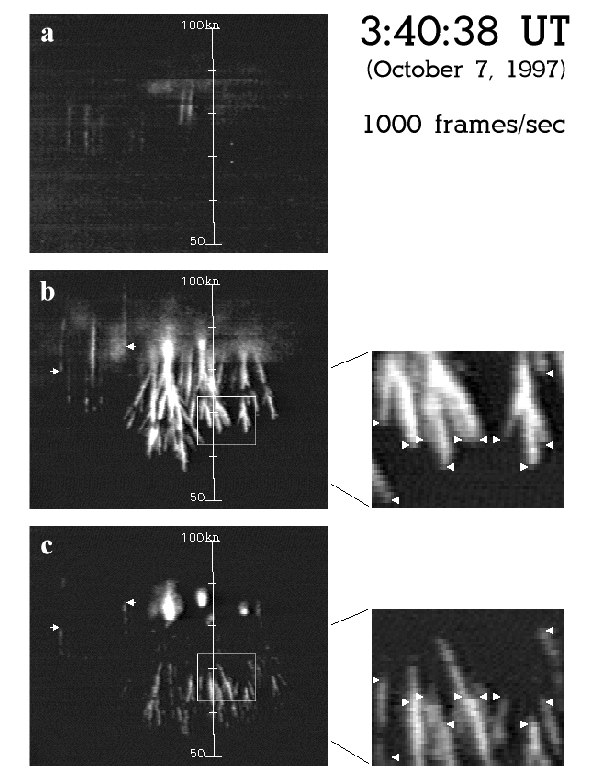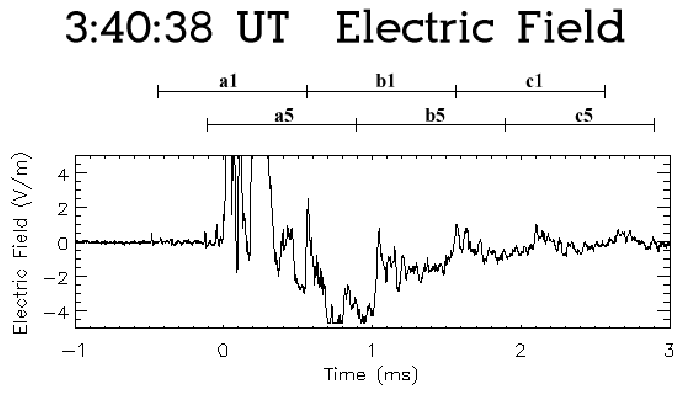 |
Figure 5.8 shows high-speed video observations obtained at 1000 fps of a cluster of columniform and angel sprites that occurred at 03:40:38 UT. These sprites were associated with a 116 kA peak-current +CG at 298 km range. The +CG was probably associated with the same flash which produced the 03:40:37 UT +CG and sprite cluster. The vertical bar in Figure 5.8 is plotted directly above the +CG location and shows the height in km above sea level. The height estimates may be somewhat in error because the radial distance of the sprites from the CG plan location is not known. A radial displacement of 40 km would result in a vertical error of about 10 km.
 |
From the time-correlated field change measurements, the beginning of
the frame (top block) in Figure 5.8a was
![]() ms prior to the arrival time of the return stroke
pulse at the observation location (see Figure 5.9).
Several luminous regions and columns, many of which are paired, are
visible in the first frame at inferred heights between 70 and 88 km.
ms prior to the arrival time of the return stroke
pulse at the observation location (see Figure 5.9).
Several luminous regions and columns, many of which are paired, are
visible in the first frame at inferred heights between 70 and 88 km.
 |
The column pair just left of the height bar in
Figure 5.8a have vertical extents of about 8 km. Taking
into account the time it takes the return stroke field change to
arrive at the altitude of the top of the columns
(
![]() ), the
longer line-of-sight light travel time from the sprites than from the
return stroke (
), the
longer line-of-sight light travel time from the sprites than from the
return stroke (
![]() ), and the video
scan information (the top of the columns are within the 5th video
block, the start of which is delayed by (5-1)
), and the video
scan information (the top of the columns are within the 5th video
block, the start of which is delayed by (5-1)![]() 83
83 ![]() s
s
![]() 330
330 ![]() s from the start of the uppermost video block), the
columns were initiated within
s from the start of the uppermost video block), the
columns were initiated within
![]() ms of the
arrival of the return stroke pulse at altitude. Since the base of the
columns extend down into the next video block, the minimum speed for
purely downward development would be about
ms of the
arrival of the return stroke pulse at altitude. Since the base of the
columns extend down into the next video block, the minimum speed for
purely downward development would be about
![]()
![]() m/s. The minimum
speed would be somewhat higher for upward development (due to the
video scan nature) and less for the upward and downward components of
bidirectional development. The similarity of the minimum velocity
estimate to other velocity estimates presented in this work may
indicate that the initiation of the sprites in
Figure 5.8a occurred well within 0.57 ms of the return
stroke.
m/s. The minimum
speed would be somewhat higher for upward development (due to the
video scan nature) and less for the upward and downward components of
bidirectional development. The similarity of the minimum velocity
estimate to other velocity estimates presented in this work may
indicate that the initiation of the sprites in
Figure 5.8a occurred well within 0.57 ms of the return
stroke.
The columns seen in the first video frame (Figure 5.8a) were in some instances brighter in the second frame (Figure 5.8b) and showed some downward development. However, the well-developed angel sprites of the second frame were not associated with detectable columns in the first frame. Rather, at least two of the angel sprites developed downwards from enhanced luminous regions visible in the first frame.
The surrounding diffuse luminosity is probably a diffuse sprite caused by conventional breakdown, as will be shown in Section 5.3.3 for a similar sprite cluster. Further evidence for this is provided by velocity measurements which will be shown below. The enhanced luminous regions may have been enhanced ionized regions with a sufficient density and geometrical separation of space charge required for streamer formation as described by Raizer et al. (1998).
In the third video frame (Figure 5.8c), the heads of the angel sprites are still luminous while the tendrils are only luminous in their downward-developing lower extremities. An expanded view of the base of the tendrils in the boxed region is presented to the right of Figure 5.8b-c. The arrows denote the lower extent of each tendril for the second frame. All but two of the tendrils propagated downward during the third frame with no significant persistence indicated at the 400 m vertical resolution of the camera system, while the two exceptions appear to be accompanied by minor persistence (these may also be a chance superposition of a foreground and background tendril). A general lack of persistence can also be seen in the overall picture of Figure 5.8b-c for the lower portion of a couple of downward developing columns (arrowed). On sufficiently short time scales, a streamer's luminosity will be dominated by emissions associated with electron impact ionization in the propagating tip (Raizer et al., 1998; Pasko et al., 1998a). The lack of persistence clearly indicates that both tendrils and the lower part of sprite columns are propagating events with visual characteristics identical to that of streamers. The downward direction of development would be in the same direction as the quasi-electrostatic field created by a positive CG (which, in effect, places negative charge into the cloud) and hence the streamers would be of positive polarity.
The most developed of the angel sprites in the second frame had a
vertical extent of about 28 km and developed at an apparent minimum
velocity of
![]() m/s. This velocity is much greater
than the average velocities reported for the tendrils of the
03:03:59 UT sprite cluster. The higher velocities would be consistent
with a larger charge moment change parent discharge
(Raizer et al., 1998), which provides further evidence that the
diffuse luminosity may be due to conventional breakdown at high
altitude.
m/s. This velocity is much greater
than the average velocities reported for the tendrils of the
03:03:59 UT sprite cluster. The higher velocities would be consistent
with a larger charge moment change parent discharge
(Raizer et al., 1998), which provides further evidence that the
diffuse luminosity may be due to conventional breakdown at high
altitude.
The brightness of the head of the sprites at an inferred altitude of 80-90 km underwent a gradual decay into later frames (not shown). This decay was observed for about 53 milliseconds.